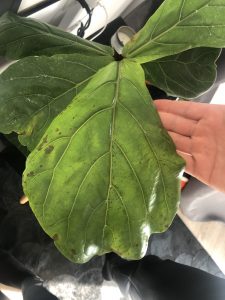
I think I may have overwatered my fiddle leaf. The top leaf has dark black spots.
Wondering what I should do about it.
I sprayed fungal spray on the leafs in case it is a fungal infection
From your photo, it looks like there are several small- to medium- sized black spots on the leaf, many of these very close to the outer edges.
If the fig’s roots are soggy from overwatering or poor drainage, root rot (a fungal disease) could be the culprit. Check this by examining the roots – take the plant out of the pot and rinse the root ball with water so you can clearly see the roots. If the roots are mushy and brown, it’s got root rot. If this is the case, use clean shears to cut off the damaged roots and also cut off the brown-spotted leaves, then repot the plant using fresh well-draining potting soil. Make sure you wash the pot out well before repotting the plant.
There are a couple of other ways to help you differentiate root rot from other possible causes of the spots. With root rot, leaves usually remain green. It usually affects older leaves first – these are generally close to the bottom of the plant, while newer growth is closer to the top. Also, if leaves are dropping (you do not mention this) – it’s likely root rot. Although root-rot is a fungal disorder, spraying the fig leaves with an anti-fungal agent will not treat the underlying cause of the spots.
Another cause of brown spots that could be your plant’s problem is bacterial infection, which mainly attacks new leaves and also can result in many brown spots that appear anywhere on the leaves. Usually the leaves would also yellow. These infections are difficult to treat successfully. Treatment includes cutting off all leaves that have brown spots and repotting the plant in fresh, sterile well-draining potting soil. Make sure the plant gets lots of sunlight and water sparingly until it starts to recover.
Other causes of brown spots that do not appear to be the problem with your plant (but are worth a mention to alert you of future issues) include where the plant is too dry – this will cause the leaves to yellow, turn brown and curl starting at the leaf edges. One way to check for this is to see if the soil is so dry it has shrunk away from the side of the pot. Dry air is an issue during our winter (it’s now late November) and placing the plant on a saucer filled with pebbles that are kept moist, and misting the leaves every few days, would help provide the plant with enough moisture. Insects can cause small dark spots on the leaves that become holes, especially on the new (tasty) leaves. Watch for insect webs on the undersides of leaves and where the leaf and stem meet. If your plant is infested, treat with insecticidal soap available from your local nursery.
Finally, taking proper care of the fig is critical to its health. Make sure the plant is located near a sunny window, away from drafts and is not over-watered. Allow the roots and soil to dry out a bit between waterings. When you water, water deeply when the top inch or so of soil feels dry (once or twice a week), and just water the soil, don’t get the leaves wet. Keep the soil under the plant clean of debris. If you fertilize the plant, flush the potting soil with water every couple of months to avoid build-up of mineral salts (these appear as small white crystals on the surface of the soil and sides of the pot).
See The Spruce’s Growing Fiddle-Leaf Fig Plants Indoors for additional information on caring for these plants.
All the best with your fig!

